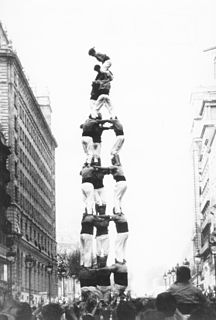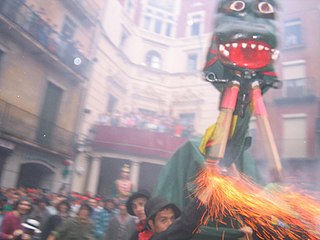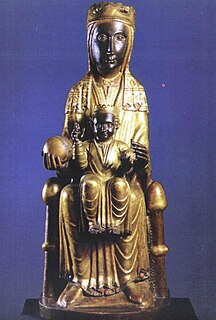 W
W2 in 8 with double base, which in Catalan is called 2 de 8 amb folre or torre de vuit amb folre, is a castellers human tower with 8 levels and 2 people per level in the trunk. It is strengthened by a second base in the second level, which helps the third level. The top crown consists of the pair, a bending child and the crowner. The last two members of the tower are the only ones that climb down through the opposite row they have used to climb up.
 W
W3 in 8, which in Catalan is called 3 de 8, is a castellers human tower with 8 levels and 3 people per level in the trunk, except for the last three levels called the top crown, which, like in most other castells, consists of the pair, a bending child and the crowner. One of the pairs, called the right pair, stands on the shoulder of a casteller of the fifth level, completing the main row usually called rengla, while the other pair, called open pair, stands with its legs open with one foot in each of the other castellers shoulder. The other two rows are called the right and left rows, or the full and empty rows. The bending child climbs up through the left/empty row, while the crowner and the open pair climb up through the right/full row. Once crowned, the crowner climbs down using the main row.
 W
W4 in 8, which in Catalan is called 4 de 8, is a castellers human tower with 8 levels and 4 people per level in the trunk, except for the last three levels called the top crown, which, like in most other castells, consists of the pair, a bending child and the crowner. It is usually the first structure with 8 levels that groups of castellers complete. It is often referred as carro gros.
 W
WThe ball de diables is a dance tradition originating from Catalonia, though it is also observed in the Valencian Community and the Balearic Islands. Over the course of centuries, the balls de diables have evolved into the modern day correfocs. Participation in the form of passacaglia (processions) and correfocs is an essential part of celebrations in many towns and cities.
 W
WA barretina is a traditional hat that was frequently worn by men in parts of the Christian cultures of the Mediterranean Sea such as Catalonia, the Valencian Community, the Balearic Islands, Provence, Corsica, Sicily, Malta, Sardinia, part of Naples, part of the Balkans and parts of Portugal.
 W
WA Caganer is a figurine depicted in the act of defecation appearing in nativity scenes in Catalonia and neighbouring areas with Catalan culture such as Andorra, Valencia, and Northern Catalonia. It is most popular and widespread in these areas, but can also be found in other areas of Spain (Murcia), Portugal, and southern Italy (Naples).
 W
WThe Casa de la Festa Major de Vilafranca del Penedès, located in the old chicken and giblets market, is a space that gathers together the rich folklore of the Vilafranca del Penedès town festival(Catalan: festa major), held between 28 August and 3 September, to honour the feast day of Sant Fèlix. Municipally owned, it is part of the Barcelona Provincial Council Local Museum Network.
 W
WA castell is a human tower built traditionally at festivals in Catalonia, the Balearic islands and the Valencian Community. At these festivals, several colles castelleres attempt to build and dismantle a tower's structure. On 16 November 2010, castells were declared by UNESCO to be amongst the Masterpieces of the Oral and Intangible Heritage of Humanity.
 W
WCastellers de Barcelona is a team of castellers from Barcelona founded in 1969.
 W
WCorrefocs ; literally in English "fire-runs") are among the most striking features present in Valencian and Catalan festivals. In the correfoc, a group of individuals will dress as devils and light up fireworks – fixed on devil's pitchforks or strung above the route. Dancing to the sound of a rhythmic drum group, they set off their fireworks among crowds of spectators. The spectators that participate dress to protect themselves against small burns and attempt to get as close as possible to the devils, running with the fire. Other spectators will watch from "safe" distances, rapidly retreating as necessary.
 W
WLa Guita Xica is a dragon that appears amongst the legends of Catalonia beginning in 1890. The dragon had many names, including Guita Boja, La Guita Xica, Mulaguita, La Mulassa, Mula Fera, and Mula Guita. Its name transformed over time, originally started as Mulassa, then Mulaguita, and finally Guita by the twentieth century. The name La Mulassa comes from an older term, mulassas, meaning 'monstrous mules,' which was used in Catalan mythology to refer to mule-dragon hybrids. La Guita Xica was originally considered a demon, but has become a protective spirit over the past century. It is also called a tarasca, which is a name for draconic creatures of Spanish and Latin American folklore.
 W
WD. Francisco de Sales Maspons y Labrós — in Catalan, Francesc de Sales Maspons i Labrós — was a Catalan folklorist, doctor of law and notary, as well as brother of the writer Maria del Pilar Maspons i Labrós. In addition to becoming dean of the notary college of Barcelona, he chaired the Jocs Florals de Barcelona in 1897 and l'Associació d'Excursions Catalana in 1883–91, and effected the latter's union with l'Associació Catalanista d'Excursions Científiques to create the Centre Excursionista de Catalunya, over which he presided (1892–96).
 W
WMinyons de Terrassa is a group of castellers from Terrassa founded on 21 June 1979 and publicly presented on 14 July 1979.
 W
WMón Casteller. The Human Tower Museum of Catalonia is a museum project that is being built in the city of Valls, capital of the Alt Camp and considered as the birthplace and zero point for human towers. The initiative is being developed through a consortium made up of the Catalan Government's Department of Culture, the Tarragona County Council, Valls City Hall and the Coordinator of Catalan Human Tower Groups. The Catalan Government will preside the consortium and Valls City Hall will execute the museum and secretariat works.
 W
WOur Lady of Montserrat or the Virgin of Montserrat is a Marian title associated with a statue of the Madonna and Child venerated at the Santa Maria de Montserrat monastery on the Montserrat Mountain in Catalonia, Spain. She is the Patron Saint of Catalonia, an honour she shares with Saint George.
 W
WPatufet is the main character of one of the most famous folktales of Catalan tradition.
 W
WThe Patum de Berga, or simply La Patum, is a popular and traditional festival that is celebrated each year in the Catalan city of Berga (Barcelona) during Corpus Christi. It consists of a series of "dances" by townspeople dressed as mystical and symbolical figures, and accompanied either by the rhythm of a drum—the tabal, whose sound gives the festival its name—or band music. The balls are marked by their solemnity and their ample use of fire and pyrotechnics.
 W
Wpillar of 6, which in Catalan is called pilar de 6, is a castellers human tower with eight levels and one person per level. Its difficulty is comparable to the 3 in 8 and the 4 in 8 and most rankings give it a punctuation similar to them. This tower was seen in the 19th century, and the last one completed before the decay of the castellers before its blooming in the 20th century was in Vilanova i la Geltrú in 1890.
 W
WThe Santa Tecla Festival is a festival held in Tarragona, Catalonia, Spain.
 W
WLes Santes is the largest festival in the city of Mataró, Spain. It is celebrated every year from the 25th to the 29th of July. The festivities include comedy shows, live music, fireworks and typical features present in catalan festivals, such as correfocs and "gegants".
 W
WThe Tió de Nadal, also known simply as Tió or Tronca ("Log"), is a character in Catalan mythology relating to a Christmas tradition widespread in Catalonia. A similar tradition exists in other places, such as the Cachafuòc or Soc de Nadal in Occitania. In Aragon it is also called Tizón de Nadal or Toza.